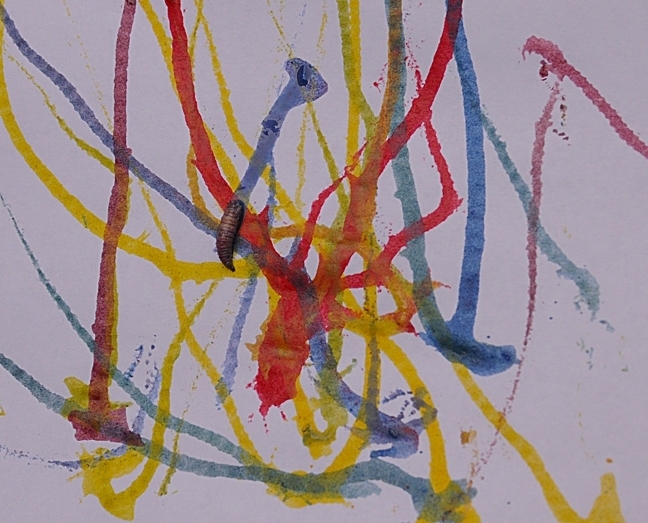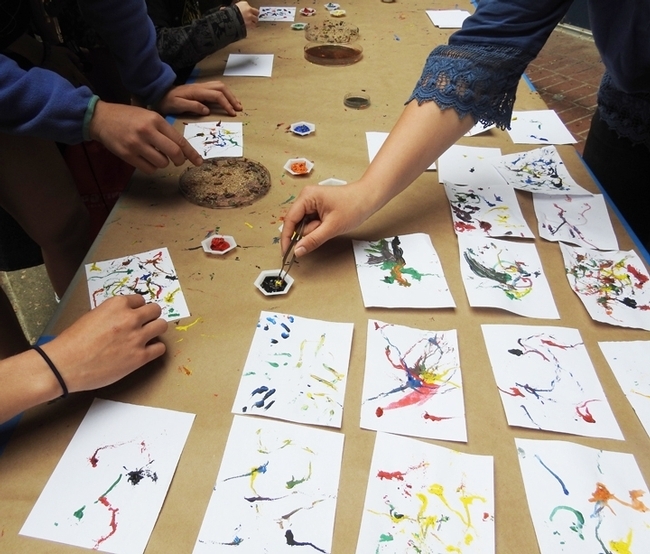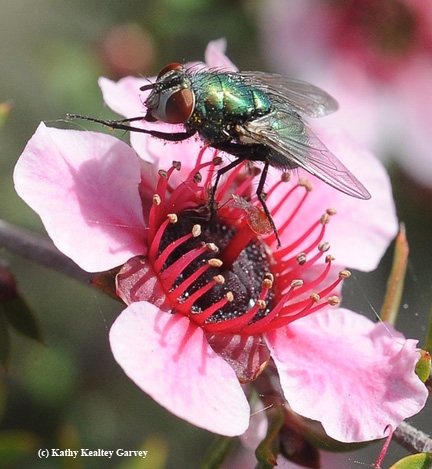That rhymes.
And that's what's planned as the family craft activity when the Bohart Museum of Entomology hosts an open house on fly research from 1 to 4 p.m., Saturday, Jan. 12 in Room 1124 of the Academic Surge Building, located on Crocker Lane, UC Davis campus. It's free and family friendly.
Bohart associate and entomology undergraduate student Wade Spencer has ordered the maggots. The tables are set up and ready.
All you do is pick up a maggot, dip it into a non-toxic, water-based paint, and let it crawl--or guide it--on a piece of paper. Voila! Art. Maggot art. And perfect for framing or posting on your refrigerator or bulletin board.
It's a conservation piece.
"Umm, what's that on your refrigerator?"
"Maggot art."
"Wh-a-a-t?"
And so the story begins.
If you've ever been to the annual UC Davis Picnic Day (this year's it's April 13) and wandered over to Briggs Hall, home of the UC Davis Department of Entomology and Nematology, you'll see Maggot Art in action. t's known as one of the most popular Picnic Day activities.
Several years ago we asked forensic entomologist Robert Kimsey of the UC Davis Department of Entomology and Nematology faculty (and a past president of the North American Forensic Entomology Association) for his take on Maggot Art.
One of his former graduate students, Rebecca O'Flaherty, coined the term and the activity back in 2001 when she was studying at the University of Hawaii. She was rearing blowflies for her forensic research and wanted an activity to draw the interest of elementary school students in her teaching program. She sought to generate interest and respect for an entomological wonder that's more associated with road kills and goose bumps than art thrills.
Her Maggot Art activity drew national interest. "The beauty of the Maggot Art program," she told me, "is its ability to give hands-on, non- experiences with an insect that most people fear or loathe."
So what was Professor Kimsey's take on it ?
"This is an extremely interesting and innovative idea that combines vry basic biology with art in a form that people can readily access and understand," he said. "It provides an entrée into the biology and development of insects that people can really appreciate and understand. It was a stroke of genius."
What the Bohart folks do is also a stroke of genius.

- Forensic entomologists Danielle Wishon, graduate of UC Davis, and doctoral student Alex Dedmon of the Robert Kimsey lab
- Fourth-year doctoral student Charlotte Herbert Alberts of the Lynn Kimsey lab, Bohart Museum, who studies assassin flies
- Graduate student Socrates Letana of the Lynn Kimsey lab, Bohart Museum, who studies botflies
- Doctoral student Caroline Wright Larsen of the James R. Carey lab, who studies non-native non-native tephritid flies, including Mediterranean fruit flies
- Graduate students Christine Tabuloc and Yao Cai and undergraduate students Cindy Truong and Christopher Ochoa, all of the Joanna Chiu lab, who research fruit flies
- Nermeen Raffat, a visiting scholar in the Sharon Lawler lab, who studies "the effect of copper sulphate and other toxicants on the development and anti-predatory behavior of the mosquitoes larvae."
Undergraduate student Kathlyne-Inez Soukhaseum of the Frank Zalom lab, who researches the fruit fly, the spotted-wing drosophila, Drosophila suzukii, was initially scheduled to participate.
Dedmon is the newest addition to the list of those who will be participating at the Bohart open house. Working with major professor Robert Kimsey, he studies forensic entomology--the use of insects as evidence in the court of law. "My work is in insect succession, or the composition and patterns of insects that come to and from a decedent," he related. "I am interested in defining these patterns, as well as the various factors that influence them. Specifically, I seek to make insect succession a more reliable tool in evaluating the postmortem interval of a decedent, that is, the time elapsed since death. Ultimately, the goal of my research is to provide a stronger foundation of evidence for forensic entomologists testifying in court."
Besides checking out the flies--and creating maggot art--this is also a good time for visitors to inquire about graduate school, ask about starting research projects, and to meet people working in forensics, evolution, agriculture, animal behavior, genetics, geography, and home pests, among other topics," said Tabatha Yang, education and outreach coordinator.
Entomologist Jeff Smith, who curates the Bohart's butterfly and moth section, will be on hand to open the Diptera section and answer questions.
"We've never had a fly specialist here at UC Davis except for mosquitoes," said Lynn Kimsey, director of the Bohart Museum and professor of entomology. "We have one of the world's largest mosquito collections. Overall, I'd guess we have 300,000 fly specimens."
The Bohart Museum houses nearly eight million insect specimens, a live "petting zoo" (think Madagascar hissing cockroaches, stick insects, tarantulas and praying mantids) and a year-around gift shop. The museum is open to the general public Mondays through Thursdays, from 9 a.m. to noon and from 1 to 5 p.m., plus occasional, weekend open houses?. Admission is free. Further information is available on the Bohart Museum website at http://bohart.ucdavis.edu/ or contact (530) 753-0493 or bmuseum@ucdavis.edu.
Attached Images:

This maggot art is the work of entomologist-artist Diane Ullman, professor of entomology at UC Davis and former chair of the department. She served as the co-founding director of the UC Davis Art/Science Fusion Program. (Photo by Kathy Keatley Garvey)

The UC Department of Entomology and Nematology offers maggot art at Briggs Hall during the annual UC Davis Picnic Day. This year's Picnic Day is set April 13. (Photo by Kathy Keatley Garvey)
